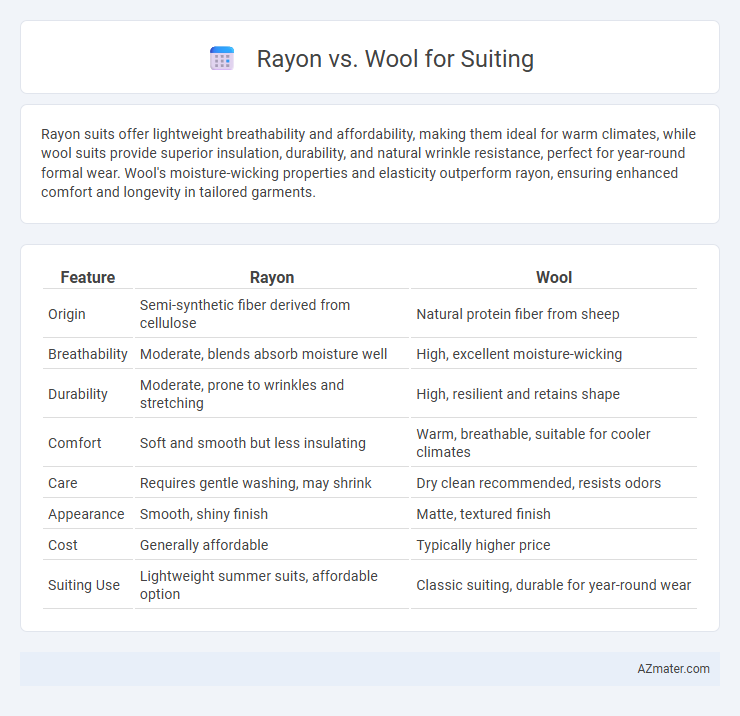Rayon suits offer lightweight breathability and affordability, making them ideal for warm climates, while wool suits provide superior insulation, durability, and natural wrinkle resistance, perfect for year-round formal wear. Wool's moisture-wicking properties and elasticity outperform rayon, ensuring enhanced comfort and longevity in tailored garments.
Table of Comparison
| Feature | Rayon | Wool |
|---|---|---|
| Origin | Semi-synthetic fiber derived from cellulose | Natural protein fiber from sheep |
| Breathability | Moderate, blends absorb moisture well | High, excellent moisture-wicking |
| Durability | Moderate, prone to wrinkles and stretching | High, resilient and retains shape |
| Comfort | Soft and smooth but less insulating | Warm, breathable, suitable for cooler climates |
| Care | Requires gentle washing, may shrink | Dry clean recommended, resists odors |
| Appearance | Smooth, shiny finish | Matte, textured finish |
| Cost | Generally affordable | Typically higher price |
| Suiting Use | Lightweight summer suits, affordable option | Classic suiting, durable for year-round wear |
Introduction to Suiting Fabrics
Rayon and wool are two popular suiting fabrics with distinct characteristics influencing comfort, durability, and appearance. Wool offers natural insulation, breathability, and wrinkle resistance, making it a classic choice for formal and professional attire. Rayon, a semi-synthetic fiber, provides a smooth texture and drapes well, often blended with other fibers to enhance affordability and softness in suiting options.
What is Rayon?
Rayon is a semi-synthetic fiber made from regenerated cellulose derived from wood pulp, often used as an affordable alternative to natural fibers in suiting. It offers a smooth texture and excellent breathability, making it comfortable for warm climates, though less durable and prone to wrinkling compared to wool. While wool provides superior insulation and wrinkle resistance, rayon suits are favored for their lightweight feel and soft drape at a lower cost.
What is Wool?
Wool is a natural fiber obtained from the fleece of sheep, known for its excellent insulation, breathability, and moisture-wicking properties, making it ideal for suiting fabrics that maintain comfort in various climates. Its natural crimp and elasticity provide durability, wrinkle resistance, and a refined appearance sought after in high-quality suits. Unlike synthetic fibers like rayon, wool offers superior temperature regulation and longevity, contributing to the luxurious feel and structured fit of bespoke and tailored garments.
Key Differences Between Rayon and Wool
Rayon suits offer a lightweight, breathable fabric derived from cellulose fibers, making them more affordable and easier to care for compared to wool. Wool suits provide superior insulation, natural wrinkle resistance, and durability due to their protein-based fibers, ideal for colder climates and formal occasions. Rayon tends to lack the elasticity and moisture-wicking properties of wool, which can impact comfort and longevity.
Comfort and Breathability Comparison
Rayon offers a lightweight, smooth texture that enhances comfort and provides moderate breathability, making it suitable for warm-weather suiting. Wool, especially merino wool, excels in moisture-wicking and temperature regulation, offering superior breathability and comfort in both cool and warm climates. The natural crimp in wool fibers allows better airflow compared to rayon's synthetic structure, resulting in improved ventilation and all-day wearability.
Durability and Maintenance
Rayon suits, made from semi-synthetic fibers, tend to be less durable than wool suits as they can weaken and pill over time, especially with frequent wear. Wool suits offer superior durability due to the natural resilience of wool fibers, retaining shape and resisting wrinkles longer. Maintenance for rayon requires gentle handling and dry cleaning to prevent damage, while wool suits benefit from regular brushing and occasional airing to maintain fabric integrity and longevity.
Appearance and Drape
Rayon suits offer a smooth, shiny appearance with a fluid drape that closely mimics silk, lending a sleek and polished look ideal for formal occasions. Wool suits feature a natural matte finish and structured drape, providing a classic, refined silhouette that maintains its shape well over time. The choice between rayon and wool impacts the overall aesthetic, with rayon emphasizing elegance and softness, while wool delivers durability and traditional style.
Cost and Affordability
Rayon suits are significantly more affordable than wool, making them a popular choice for budget-conscious consumers who want a formal look without the high price tag. Wool, known for its durability, natural breathability, and superior insulation, generally commands a higher price due to its quality and longevity. While rayon offers cost-efficiency and a smooth finish, wool suits deliver better value over time despite the initial investment.
Eco-Friendliness and Sustainability
Rayon suits are made from regenerated cellulose fibers, often derived from wood pulp, which can contribute to deforestation and involve chemically intensive production processes, impacting their overall sustainability. Wool, sourced from sheep, is a renewable and biodegradable natural fiber with a lower environmental footprint when sourced responsibly through sustainable grazing practices and ethical farming. Choosing wool suiting supports eco-friendliness by promoting animal welfare and reducing reliance on synthetic chemicals compared to rayon alternatives.
Choosing the Right Fabric for Your Suit
Rayon offers a smooth texture and affordability, making it suitable for lightweight, breathable suits ideal for warmer climates, while wool provides superior insulation, durability, and natural wrinkle resistance, perfect for year-round wear and formal occasions. Wool suits maintain their shape and offer moisture-wicking properties, which enhance comfort and longevity compared to rayon's tendency to wrinkle and absorb moisture. Selecting between rayon and wool depends on climate, occasion, budget, and the desired balance between breathability and durability for your suiting needs.

Infographic: Rayon vs Wool for Suiting
 azmater.com
azmater.com